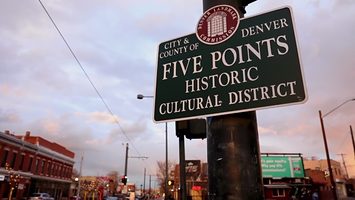The Harlem of the West: Denver’s Historic “Five Points” Neighborhood
Escaping the Jim Crow South, black migrants settled in Denver only for segregation to follow them. Yet they still built a vibrant, prosperous community in the Five Points at the turn of the twentieth century.

The historic “Five Points” community has a deep historical legacy as one of America’s most prominent black neighborhoods. Located next to downtown Denver’s central business district, Five Points rose to prominence during the first half of the twentieth century as an epicenter of black arts, culture, and entertainment.
Denver—known as the “Mile High City” for its high elevation—was a mere six years old when the Civil War concluded. Newly freed slaves were migrating west, with a trickle becoming a flood by the 1870s as the “Exodusters” escaped the Deep South and Jim Crow segregation. They settled first in the Midwest and built communities like Nicodemus, Kansas, but some continued westward, eventually landing just north of Denver’s center city around the intersections of East 26th Avenue and Welton Street as well as 27th and Washington Streets.
It was known as “Five Points,” an abbreviated name for the streetcar stop. Initially, the neighborhood was home to Denver’s white elite and middle-class. But as the city continued to grow, wealthy Coloradans left Five Points for newer, upscale neighborhoods like Capitol Hill.
That created an opportunity. In the 1890s, Five Points welcomed a sharp influx of black residents looking to own a house in an attractive, prosperous neighborhood. However, once there, it was hard to leave. By the early twentieth century, restrictive neighborhood covenants, redlining, and other discriminatory housing practices kept Denver’s residents segregated in the Five Points. In the 1920s, fully 90 percent of Denver’s black population was concentrated in just this 2.3 square mile area.
And even if the policies that forged Five Points were intended for ill, they unintentionally created a vibrant, concentrated, upwardly-mobile black community. It had more black-owned enterprises than any other community in the U.S. outside of Harlem, giving it its nickname, the “Harlem of the West.” Candace Taylor, author of Overground Railroad: The Green Book and the Roots of Black Travel in America, describes just how exceptional Five Points was during this period:
Denver’s Five Points district played an important role for black travelers headed west. In most western cities, black people comprised only about 3 percent of the population. This wasn’t true for Five Points. In 1870, there were roughly two hundred black residents, but by 1920, after the first wave of the Great Migration, there were more than five thousand, making it one of the largest African-American communities west of the Mississippi River. And because there were so few options for black people to stay in that area of the country, Five Points was a necessary stopping place for black migrants traveling west.
One of the neighborhood’s most famous residents was Madam C.J. Walker, who moved there in 1906 and soon became a millionaire selling hair care products for black women. Five Points is what Tulsa, Oklahoma’s famous “Black Wall Street” might have looked like but for the massacre of 1921, though both are a reminder of how hard it was to escape the spectre of Jim Crow.
Still, Five Points thrived through the 1950s, with many commercial buildings dotting Welton Street, the area’s main arterial road. That included physician offices, mortgage lenders, numerous dining establishments, a number of grocery and drug stores, five liquor stores, a clothing store, a couple of shoe-repair shops, and a funeral home. Welton Street also featured more than fifty bars and musical venues, where well-known black jazz musicians such as Duke Ellington, Miles David, Ella Fitzgerald, Dizzy Gillespie, and Billie Holiday performed for a growing black middle class.
In 1912, the owner of the Baxter Cigar Company commissioned architect George Louis Bettcher to design a three-story, Beaux-Arts style structure at the Five Points crossroads on Welton. This community landmark, known as the Baxter Hotel (and renamed the Rossonian Hotel in 1929), quickly became a legendary locale for music enthusiasts from all over the country, who traveled from club to club and from coast to coast to places like the Baxter. The hotel’s lounge welcomed jazz musicians and enthusiasts into the wee hours of the morning. By the 1950s, however, the lounge’s clientele became predominantly white because of rising cover charges.
Indeed, during the 1950s through the 1990s the Five Points community suffered a precipitous decline as racist housing restrictions gradually eased and wealthier black residents relocated to newer housing tracts as a part of the postwar suburban boom. The area became besieged by crime and many properties were abandoned, further dragging down property values. Denver’s downtown fell prey to the general urban decline affecting most American cities at the time. Efforts to redevelop the area were hampered by tepid, broken promises of reinvestment.
However, the area has experienced an economic resurgence in recent years with the addition of a major mixed-use housing and retail complex. There are also plans led by former NBA basketball star and Denver resident Chauncey Billups to restore the historic Rossonian Hotel and Lounge.
In 2002, Five Points was designated a cultural historical district, reflecting its pivotal role in Denver’s black history. Those interested in learning more should visit the Blair-Caldwell African American Research Library located on Welton Street, which is also the location of Denver’s annual Juneteenth celebration.